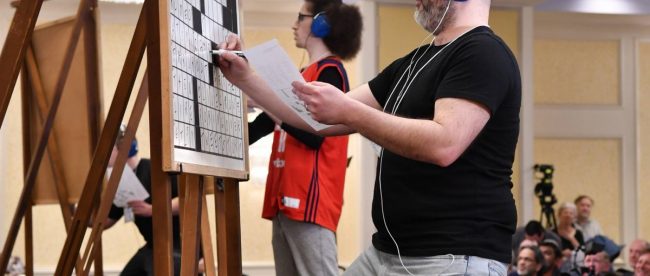The Race to Letter the Boxes


If you were in Stamford, Connecticut, a year ago, you could have been one of the hundreds of people witnessing the event above. Three people, standing in the front of a conference center, marker and a sheet of paper in hand, headphones blocking out any noise behind them. In front of them? A huge crossword grid, ready to be solved. The person who finished first would be crowned champion of the 2018 American Crossword Puzzle Tournament — the Super Bowl of word puzzles if there ever was one.
The guy in the red jersey, a former Jeopardy! champ named Erik Agard, won last year’s event. This year, though, the man to his left, in the black shirt, took the trophy. That’s Dan Feyer, and he’s probably the best crossword puzzle solver on the planet. In 2008, Feyer entered the ACPT for the first time, and right away he did well — he won the Rookie division. The next year, now competing against veteran puzzle solvers, he finished fourth overall. In 2010, he took the whole thing — and then repeated the feat for the next five years. He had an off year in 2016, coming in second, won again in 2017, came in second (to Agard) in 2018, and then won his eighth title just last week. When it comes to speedily solving crossword puzzles, there probably isn’t a person alive who can regularly outrace Feyer.
And there probably isn’t a computer who can beat him, either. But not due to lack of trying.
In 2012, a crossword puzzle writer and computer programmer named Matt Ginsberg decided to enter the ACPT, but, it turned out, that while he was adept at creating the puzzles, he wasn’t all that good at actually solving them — at least not relative to guys like Feyer and Agard. So Ginsberg decided to combine his love of crosswords with his programming skills. He began coding what he’d call Dr. Fill (get it?) the world’s first notable crossword-solving AI. And while the computer program wasn’t an official entrant into the ACPT that year or in the years since — that wouldn’t be fair — it still was allowed to compete, unofficially.
Feyer and the rest of the crossword-puzzle solving elite were up to the challenge. It turns out that despite being able to solve simple problems in just a second or two, Dr. Fill isn’t unbeatable. It’s still prone to making mistakes — for example, as the Boston Globe highlighted, it struggled with a clue from a 2010 New York Times puzzle, “Apollo 11 and 12 [180 degrees].” (The correct answer is “SNOISSIWNOOW” and as the Globe explains, “a very clever human would eventually realize that when the answer is rotated 180 degrees, the upside-down letters spell out MOON MISSIONS.”) And at the ACPT, getting a square wrong is the best way to lose points, regardless of your speed in solving the rest of the puzzle.
A few errors were all Feyer needed to triumph over the unofficial AI competitor. Feyer took the top spot with 12,305 points, earning him a spot on stage with the other two finalists; Dr. Fill scored 11,795, which would have been good enough for 14th overall had it been human. (Agard, for what it’s worth, also topped the computer this year; he finished in seventh.) In the world of crossword puzzles, humans have triumphed over machines — for now.
Not really a bonus fact but I don’t know what to call it: Think you can outrace Feyer, but don’t want to wait until the 2020 tournament to find out? No worries. Feyer does a few crosswords each day and then posts an editable spreadsheet with his times on it. You can check that out, here,
From the Archives: Soothsaying Crossword: How a crossword puzzle predicted a Presidential election.
